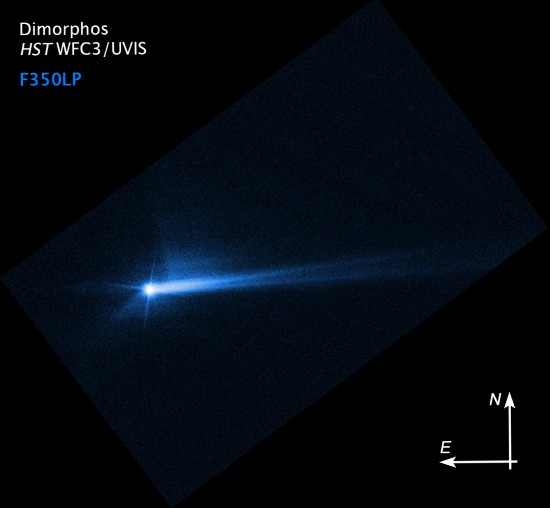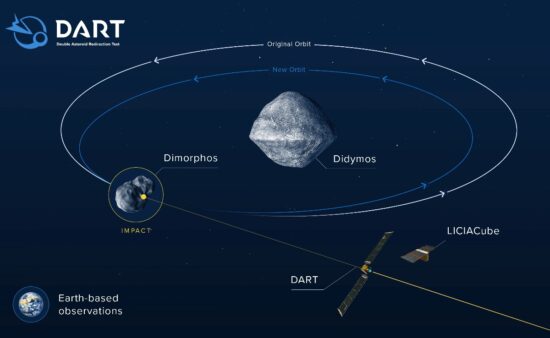The DART mission, the acronym standing for Double Asteroid Redirection Test, which reached the Didymos asteroid and impacted its moonlet, Dimorphos, on September 26, 2022, has been deemed a success.
DART was launched in November of 2021. Its target was the binary asteroid system explicitly chosen to demonstrate a method of deflecting a space rock should one be on a collision course with Earth at some future date.
The choice of the binary, Didymos-Dimorphos, was deliberate because its orbit does not intersect with Earth and, therefore, poses no near-term threat. As a binary system, it could effectively demonstrate the redirection strategy being tested as a planetary defence.
The DART spacecraft (see illustration above) was accompanied on the mission by a small companion satellite, LICIACube, the latter to observe and measure the test. The impact was timed to occur when Didymos-Dimorphos was 11 million (7 million miles) from Earth.
Dimorphos’ mass was estimated to be 5 billion kilograms (11 billion pounds). Its known orbital period around Didymos was 11 hours and 55 minutes. DART at 570 kilograms (1,260 pounds) struck the moonlet travelling at a speed of 6.6 kilometres per second or 22,530 kilometres per hour (4 miles per second or 14,000 mph). In theory, the impact’s kinetic energy would alter the orbit moving Dimorphos closer to Didymos. It was believed that the kinetic force applied during the impact would not be enough to disrupt or destroy the asteroid.
Since the September 26th impact date, NASA has been analyzing the data. Dimorphos orbit is now 32 minutes (plus or minus 2) shorter. In a NASA press release on October 11, 2022, Lori Glaze, Director of NASA’s Planetary Science Division in Washington, pointed out that NASA “will be able to better assess whether, and how, a mission like DART could be used in the future to help protect Earth from a collision with an asteroid if we ever discover one headed our way.”
The LICIACube that accompanied DART will continue to monitor the impact results assessing changes to Dimorphos’ mass and shape. So far the impactor has created a plume of debris that stretches well into surrounding space as can be seen in the image appearing at the top of this posting. It looks like a comet’s tail.
A follow-up mission by the European Space Agency, called Hera is planned for four years from now to observe the changes to the binary asteroid system, study the impact crater, and measure the moonlet’s change in mass.
Is The Threat Real Or Is This Hype?
While we currently do not know of asteroids larger than 140 metres (approximately 460 feet) in diameter that will collide with us in the next hundred years, we can only account for about 40% of the rocks in our near-Earth space.
A look at recent history, however, suggests that asteroid strike occurrences are not rare. For example, in the 21st century, we had a 2008 4-metre (13-foot) rock weighing 80 tons explode over Sudan raining meteorite fragments across the Nubian desert. In 2013 a 20-metre (66-feet) diameter rock did the same over the city of Chelyabinsk in Russia causing injuries to thousands and damaging buildings and infrastructure. The Chelyabinsk rock was greater in mass than the Eiffel Tower and the airburst equalled 500 kilotons of TNT or 20 to 30 times the energy of the Hiroshima atomic bomb. Less than 24 hours later another space rock, 30 metres (approximately 100 feet) in diameter passed Earth at a distance of 27,700 kilometres (17, 211 miles).
Going back over a century, an asteroid fragment in 1908 exploded over the Tunguska region of Siberia, flattening forests for tens of kilometres. Further back in time an asteroid fragment 50,000 years ago impacted near where Winslow, Arizona is today. Its estimated size was between 30 and 50 metres with an impact force equivalent to a 15-megaton atomic bomb (1,200 times more powerful than the bomb that fell on Hiroshima).
And the most famous of all is the 66-million-year-ago dinosaur-killing impactor that was probably 10 kilometres (6 miles) in diameter packing 100 million megatons of force and leading to a worldwide extinction event.
Are dinosaur-killing asteroids rare? Based on recent research, the occurrence rate of space rocks bigger than 5 kilometres (3 miles) across is between 16 and 32 impacts every billion years which is ten times the rate previously thought.
That’s why the DART experiment is significant as is the mapping of near-Earth space which to date has catalogued over 28,000 rocks passing through the inner Solar System (December 20, 2021 count).
The Jet Propulsion Laboratory in Pasadena, California, in cooperation with the U.S. Space Force, hosts a website that tracks and studies near-Earth objects (NEOs). What remains hard to track are the space rocks that enter near-Earth space from the outer Solar System or from interstellar space as one-time visitors. Detecting them with enough advanced warning to launch an impactor would be a challenge. And it should be noted that sometimes a space rock comes out of the Sun from a completely unexpected direction as was the case with the Chelyabinsk rock.










[…] NASA’s DART (Double Asteroid Redirection Test) mission launched in November 2021, was the first test of what could become standard practice to defend the planet from errant space rocks. In September 2022, the spacecraft deliberately plowed into Dimorphos. a companion space rock to the near-Earth asteroid named Didymos. The collision was a planetary defence test to see if the kinetic energy created by the impact of a projectile could alter the trajectory of its target. Based on observations since the collision, Dimorphos has seen its orbit of Didymos change. Four years from now a European Space Agency mission will once more visit Didymos to measure the changes DART caused. […]